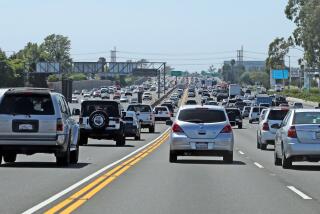Editorial: Speeding cars kill. So why is California slow-walking efforts to slow them down?
- Share via
The way California cities are required to set speed limits is outdated, absurd and downright dangerous for pedestrians and bicyclists — and it’s not even backed up by scientific research on safety.
That’s why, at a time when many communities are seeking to slow down cars to save lives, cities are still being forced to raise speed limits as a condition of enforcing their traffic laws. It’s dangerous and counterproductive, and it’s about time state lawmakers fix the problem. They will have another chance to do so this year, and they should seize it.
The problem stems from a decades-old state law that essentially requires cities to set speed limits based on how fast people are already driving on that stretch of road, regardless of whether that speed is safe or whether the street has a history of wrecks. It was adopted more than 60 years ago to prevent cities from setting speed traps, or arbitrarily low speed limits aimed at sticking drivers with pricey tickets.
The way the law works is that in order for police to use radar guns or other electronic devices to help enforce speed limits on a particular street, cities have to conduct regular surveys of traffic there. The limit must then be set at a speed exceeded by only 15% of the vehicles surveyed, rounded to the nearest 5 mph. The mandate means that if cities want to enforce the speed limit on a street where drivers routinely put the pedal to the metal, they often have to raise it to a level where most of that behavior would be legal.
For example, Zelzah Avenue in the San Fernando Valley is one of the most dangerous streets Los Angeles for pedestrians and cyclists, yet city officials have had to raise the speed limit twice over a decade from 35 mph to 45 mph so police officers could use radar guns to more easily catch and ticket speeders.
Why is California clinging to such a backward way of setting speed limits?
Assemblywoman Laura Friedman (D-Glendale) has been trying to bring some sanity to speed limits, with limited success. In 2018, she proposed amending the law to give cities more authority to lower speeds on dangerous streets. But the proposal was too aggressive for car-centric lawmakers, and she settled for the creation of the Zero Traffic Fatalities Task Force to review the speed limit law.
The task force, which recently issued its report, found that California has been relying on a flawed methodology to set speed limits. The 85th percentile standard was developed using research primarily conducted on rural roads. The rule is based on the assumption that most drivers will drive at a safe and reasonable speed, and that it’s safer to set speed limits that reflect the “natural” flow of traffic.
But more recent research suggests that drivers don’t naturally choose prudent speeds and, in fact, they frequently underestimate how fast they’re driving by 10% to 30%. The National Transportation Safety Board has said there is no convincing evidence that pegging speed limits to traffic flow results in safer streets.
The more common and unintended consequence of the 85th percentile rule is what’s known as speed creep. Higher speed limits encourage motorists to drive faster, which in turn prompts higher speed limits. That’s what happened on Zelzah Avenue in L.A.
It’s not surprising, then, that the task force has recommended giving cities more flexibility to set lower speed limits, particularly on streets with lots of injury crashes or an abundance of pedestrians and cyclists. Research shows that speed limits do affect drivers’ behavior, and even modest reductions in speed can save lives. A pedestrian or cyclist hit by a vehicle traveling 35 miles per hour has a 68% chance of survival. A person hit by vehicle traveling at 40 mph — just 5 mph faster — has only a 35% chance of survival.
Friedman has introduced one bill so far to implement the task force’s recommendations, and there is further work ahead to give cities more freedom and funding to make streets safer. Lower speed limits by themselves won’t solve the problem. Cities need to engineer streets for safety, which can mean redesigning roads and intersections to make drivers slow down. It also means ensuring that communities have protected bike lanes, sidewalks and safe pedestrian crossings.
None of these steps will be easy; Californians have fiercely resisted safety-promoting reforms that might slow their commutes. But at the very least, lawmakers should get rid of a system that forces cities to give in to speeders before cracking down on them.
More to Read
A cure for the common opinion
Get thought-provoking perspectives with our weekly newsletter.
You may occasionally receive promotional content from the Los Angeles Times.










